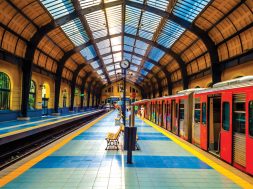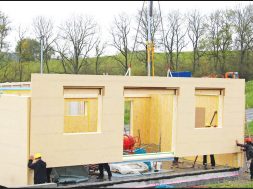Architecture to have shining future in India
“We believe that architecture is a collective responsibility of the society to build the habitat,” says Architect Dikshu C Kukreja
Architecture was in-built in Dikshu C Kukreja subconscious from his early years. It was clear that he would be an architect who would not just design buildings but make a difference. In an exclusive interview, Architect Kukreja shares why he took the responsibility of contributing to the ‘city-building’ in his country through good architecture.
Journey in the field of architectureAfter completing bachelor’s degree in architecture from the School of Planning and Architecture in Delhi, my fleeting dreams to delve deep into the discipline took me to Taliesin, the Frank Lloyd Wright School of Architecture in United States, followed by receiving a master’s degree from Harvard University which fuelled my passion for making a difference in the built environment, rather than simply making a building. The working experience in France strengthened my design skills, enriched my taste for architectural and artistic aesthetics. Most of all, it inspired me to take the responsibility of contributing to the ‘city-building’ in my own country through good architecture that may raise the social value of “architectural design” in the Indian context. So I returned to India to join C. P. Kukreja Architects.
Challenges facedAs an organisation or rather as a team dedicated to inspire the society through designing buildings, we believe that architecture is a collective responsibility of the society to build the habitat. Architects, in particular, are in a position to take the initiative in leading the mass in building the future through practice, education and sharing ideas. The most significant of them being putting across the message through their designs in order to create architectural awareness in society. Unfortunately, our cities continue to witness construction of incompatible and poor architecture which would not have been possible had it been done by an ‘architecturally conscious mind’. The government and local bodies also fail to implement norms which can ensure the professional administration in construction. Above all, the immense pressure of development, the rising and falling economic scales, the yearn for matching the ambitious projects of the West, and the demand for real estate in the market impart its significance in any building project. They also dwarf the other crucial factors like liveability, safety norms and environmental consciousness in the realisation of any architectural design. No matter how well-planned and how synchronised management of development of a project seem is, the realisation of the same faces a huge pressure from the factors that tend to derail the real situation from
28the planned one. In a nutshell, a working design in an Indian context often tends to find itself far away from an efficient design. In such a situation, it is very difficult for an architect to deliver the best design solution.Moreover, the common Indian’s perception of architecture is not very strong, and such ignorance is owing to the development being confined to urban areas in only a handful of cities. As a result of this, very few understand the science of designing a habitat with respect to environment and culture. Many do not understand even the role of an architect in making a building. Such negligence ends up in any building activity being dictated by a private developer or a chief engineer, who often concentrate on personal benefits, neglecting the holistic approach of design and welfare of the society as a whole.
Today, architects have energy and exposure to make the necessary changes. It is ‘commitment’ that is most required at present and in building a promising future for which sometimes architects and engineers have to rise above their personal gains for the holistic good of the majority.
Remarkable achievementsOur team has been consistent in delivering meaningful architecture through significant projects over the last four decades which has not only made a difference in many Indian cities but in abroad too. Concepts of eco-friendly design, culturally responsive architecture, and futuristic and innovative ideas have been propagated through design and construction of numerous projects. Even practice has achieved many success milestones from delivering the design of one of the largest to the tallest buildings in the country, promising that every project is special in its own way and gives out a significant message about the very idea of ‘architecture’ and its future to the society and beyond. The projects have explored different building typologies, from residences to institutions, from commercial to administrative buildings, each of whose designs has been created with a vision of its performance in future. In doing so, the firm has experimented though years and come up with innovations in building designs, methods of construction, respecting environmental conditions, achieving efficiency in space and energy utilisation and many other horizontal architecture can respond to.
Awards wonWe do not see awards as a mean of satiating our personal glory. Rather, they are an opportunity to reflect on the right initiatives and be a source of inspiration to strive for higher goals. We have been fortunate to consistently receive national and international awards. From often being selected as best architects in India to the top 100 in the world, from C. P. Kukreja being felicitated by the President of India to receiving the Gold Medal in architecture from Indian Institute of Architects, from Dikshu C. Kukreja being selected as young and most sought-after architect in India by Union Minister of Urban Development to being chosen as face of 21st century architecture in India.
Future outlookArchitecture has a very prosperous future in India and holds a lot of promise for young architects, engineers and all who look forward to contributing to the discipline in coming days. Being a developing country, India surely has to face a huge number of challenges, and architecture is a significant one among them. In spite of the difficulties in development, there is a lot of hope. Unlike the West, which is already developed and has very less room for future expansion, architecture in India with rapid urban morphogenesis has an extended arm into the future. Having the opportunity for a lot of future development, architecture in India holds the responsibility of incorporating the innovative ideas (like architecture for over-populated cities, economically and environmentally conscious design, architecture for social capital) in building the future by shaping, de-shaping and reshaping the built and the unbuilt.
Worst projects Some projects in this country have proven to be inefficient and been a setback to the profession in the development scenario. Though flaws, they are actually eye openers for the young architects who look to learn not only from the good examples, but also from the failures of the bad ones. Some that deserve mention here are the several government mass housing, slum rehabilitation projects, the development of the JJ Colonies and urban villages of Delhi or even some of the commercial district centres and plazas — many of these have not respected the environmental factors at all, while some have not been able to deliver quality open spaces. Many such designs look like extruded blocks in skyline, tearing into each other, with claustrophobic spaces. The liveability of such designs has not been given a thought at all, forcing people to manage in inhuman conditions in day to day life. These are not to be left aside and neglected, but taken into account in future both in developing new areas and transformation of the archaic old ones which, as a whole, will promise a new genre of development in the country and beyond.
18
Cookie Consent
We use cookies to personalize your experience. By continuing to visit this website you agree to our Terms & Conditions, Privacy Policy and Cookie Policy.









